Business Law Report: Analysis of Contract and Corporate Law Issues
VerifiedAdded on 2022/09/16
|9
|2272
|13
Report
AI Summary
This business law report addresses two key areas: contract law and corporate law. Part A examines contract formation, specifically focusing on offer, acceptance, and the creation of a valid contract, with reference to relevant case law such as Smith v Hughes and Hyde v. Wrench. The analysis considers scenarios involving offers, counteroffers, and the communication of acceptance. Part B delves into corporate law, assessing the consequences of transactions made by a managing director on behalf of a company, Sparkling Pty Ltd. It explores the application of sections 125, 126, 127, 128, and 129 of the Corporations Act, including issues of director's authority, indoor management rules, and the potential liability of the company. The report concludes with an analysis of the legal outcomes and considerations for each part of the assignment.
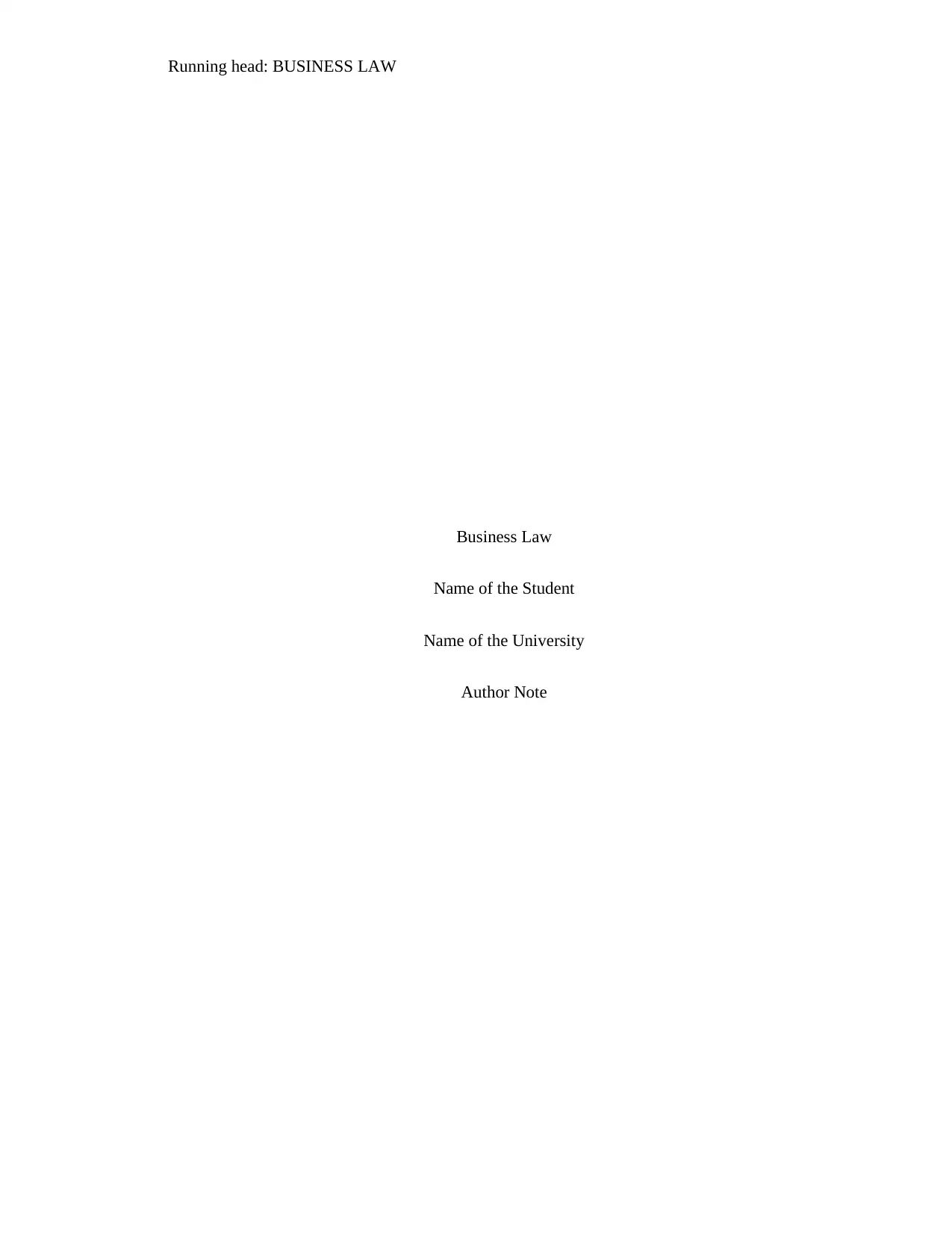
Running head: BUSINESS LAW
Business Law
Name of the Student
Name of the University
Author Note
Business Law
Name of the Student
Name of the University
Author Note
Paraphrase This Document
Need a fresh take? Get an instant paraphrase of this document with our AI Paraphraser
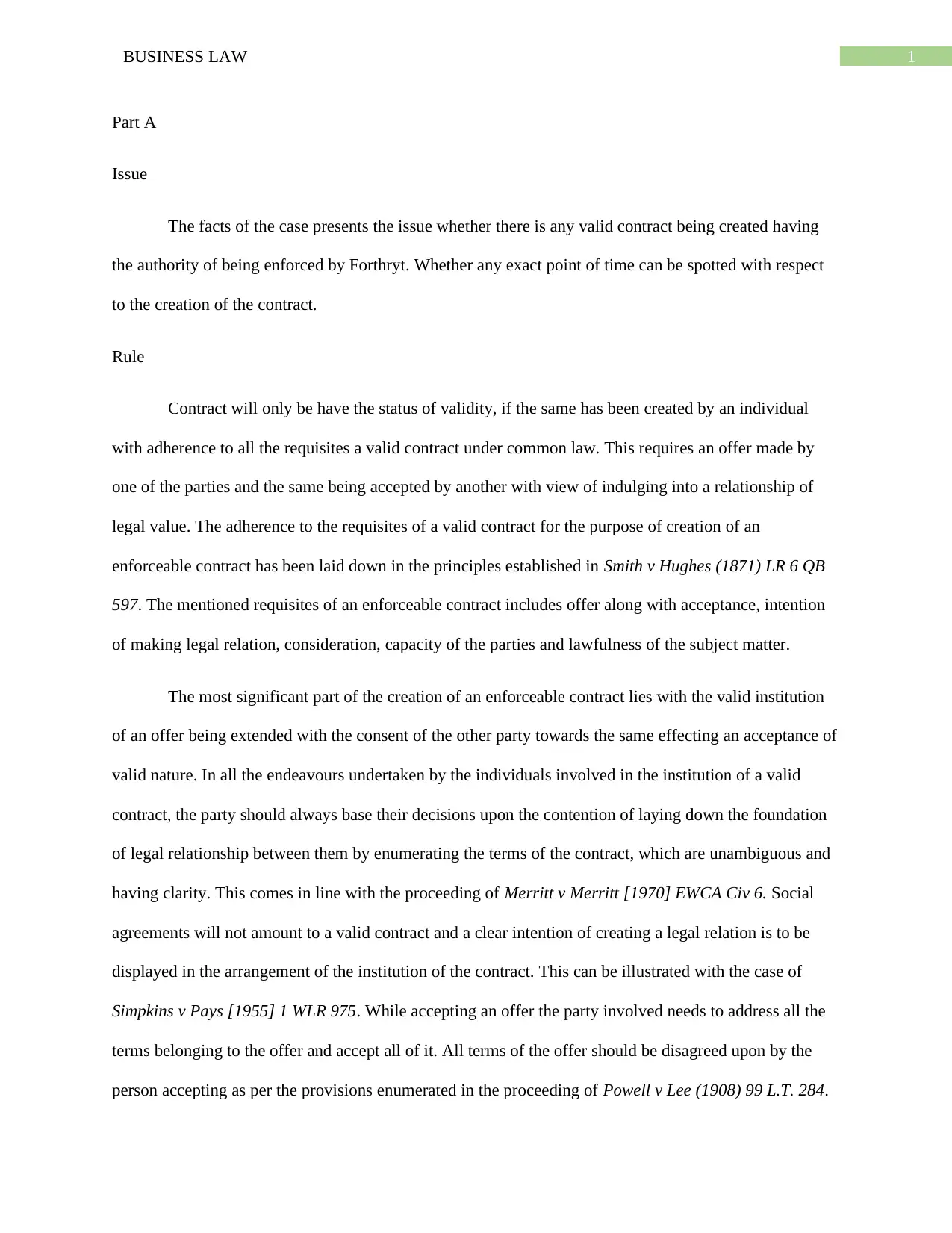
1BUSINESS LAW
Part A
Issue
The facts of the case presents the issue whether there is any valid contract being created having
the authority of being enforced by Forthryt. Whether any exact point of time can be spotted with respect
to the creation of the contract.
Rule
Contract will only be have the status of validity, if the same has been created by an individual
with adherence to all the requisites a valid contract under common law. This requires an offer made by
one of the parties and the same being accepted by another with view of indulging into a relationship of
legal value. The adherence to the requisites of a valid contract for the purpose of creation of an
enforceable contract has been laid down in the principles established in Smith v Hughes (1871) LR 6 QB
597. The mentioned requisites of an enforceable contract includes offer along with acceptance, intention
of making legal relation, consideration, capacity of the parties and lawfulness of the subject matter.
The most significant part of the creation of an enforceable contract lies with the valid institution
of an offer being extended with the consent of the other party towards the same effecting an acceptance of
valid nature. In all the endeavours undertaken by the individuals involved in the institution of a valid
contract, the party should always base their decisions upon the contention of laying down the foundation
of legal relationship between them by enumerating the terms of the contract, which are unambiguous and
having clarity. This comes in line with the proceeding of Merritt v Merritt [1970] EWCA Civ 6. Social
agreements will not amount to a valid contract and a clear intention of creating a legal relation is to be
displayed in the arrangement of the institution of the contract. This can be illustrated with the case of
Simpkins v Pays [1955] 1 WLR 975. While accepting an offer the party involved needs to address all the
terms belonging to the offer and accept all of it. All terms of the offer should be disagreed upon by the
person accepting as per the provisions enumerated in the proceeding of Powell v Lee (1908) 99 L.T. 284.
Part A
Issue
The facts of the case presents the issue whether there is any valid contract being created having
the authority of being enforced by Forthryt. Whether any exact point of time can be spotted with respect
to the creation of the contract.
Rule
Contract will only be have the status of validity, if the same has been created by an individual
with adherence to all the requisites a valid contract under common law. This requires an offer made by
one of the parties and the same being accepted by another with view of indulging into a relationship of
legal value. The adherence to the requisites of a valid contract for the purpose of creation of an
enforceable contract has been laid down in the principles established in Smith v Hughes (1871) LR 6 QB
597. The mentioned requisites of an enforceable contract includes offer along with acceptance, intention
of making legal relation, consideration, capacity of the parties and lawfulness of the subject matter.
The most significant part of the creation of an enforceable contract lies with the valid institution
of an offer being extended with the consent of the other party towards the same effecting an acceptance of
valid nature. In all the endeavours undertaken by the individuals involved in the institution of a valid
contract, the party should always base their decisions upon the contention of laying down the foundation
of legal relationship between them by enumerating the terms of the contract, which are unambiguous and
having clarity. This comes in line with the proceeding of Merritt v Merritt [1970] EWCA Civ 6. Social
agreements will not amount to a valid contract and a clear intention of creating a legal relation is to be
displayed in the arrangement of the institution of the contract. This can be illustrated with the case of
Simpkins v Pays [1955] 1 WLR 975. While accepting an offer the party involved needs to address all the
terms belonging to the offer and accept all of it. All terms of the offer should be disagreed upon by the
person accepting as per the provisions enumerated in the proceeding of Powell v Lee (1908) 99 L.T. 284.
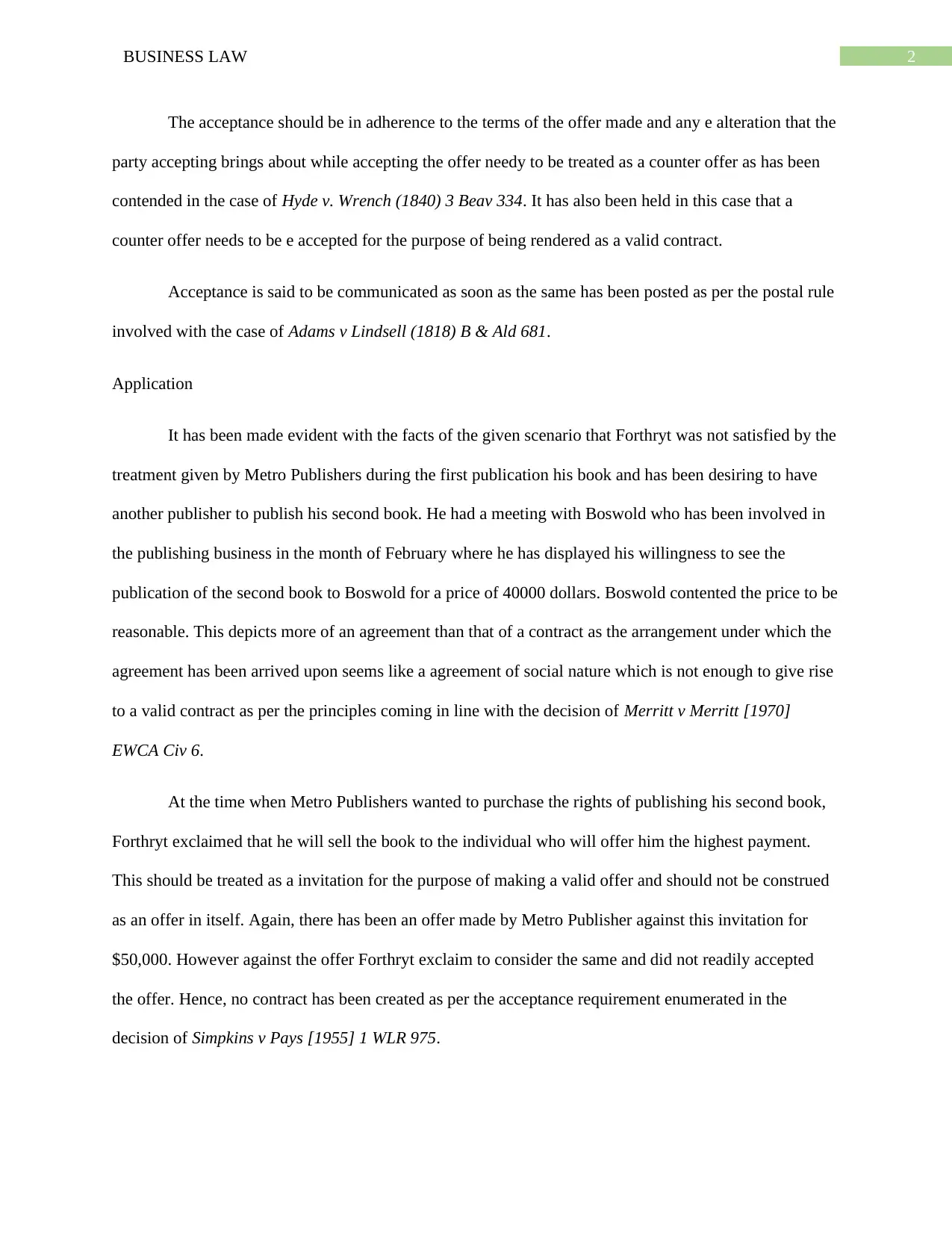
2BUSINESS LAW
The acceptance should be in adherence to the terms of the offer made and any e alteration that the
party accepting brings about while accepting the offer needy to be treated as a counter offer as has been
contended in the case of Hyde v. Wrench (1840) 3 Beav 334. It has also been held in this case that a
counter offer needs to be e accepted for the purpose of being rendered as a valid contract.
Acceptance is said to be communicated as soon as the same has been posted as per the postal rule
involved with the case of Adams v Lindsell (1818) B & Ald 681.
Application
It has been made evident with the facts of the given scenario that Forthryt was not satisfied by the
treatment given by Metro Publishers during the first publication his book and has been desiring to have
another publisher to publish his second book. He had a meeting with Boswold who has been involved in
the publishing business in the month of February where he has displayed his willingness to see the
publication of the second book to Boswold for a price of 40000 dollars. Boswold contented the price to be
reasonable. This depicts more of an agreement than that of a contract as the arrangement under which the
agreement has been arrived upon seems like a agreement of social nature which is not enough to give rise
to a valid contract as per the principles coming in line with the decision of Merritt v Merritt [1970]
EWCA Civ 6.
At the time when Metro Publishers wanted to purchase the rights of publishing his second book,
Forthryt exclaimed that he will sell the book to the individual who will offer him the highest payment.
This should be treated as a invitation for the purpose of making a valid offer and should not be construed
as an offer in itself. Again, there has been an offer made by Metro Publisher against this invitation for
$50,000. However against the offer Forthryt exclaim to consider the same and did not readily accepted
the offer. Hence, no contract has been created as per the acceptance requirement enumerated in the
decision of Simpkins v Pays [1955] 1 WLR 975.
The acceptance should be in adherence to the terms of the offer made and any e alteration that the
party accepting brings about while accepting the offer needy to be treated as a counter offer as has been
contended in the case of Hyde v. Wrench (1840) 3 Beav 334. It has also been held in this case that a
counter offer needs to be e accepted for the purpose of being rendered as a valid contract.
Acceptance is said to be communicated as soon as the same has been posted as per the postal rule
involved with the case of Adams v Lindsell (1818) B & Ald 681.
Application
It has been made evident with the facts of the given scenario that Forthryt was not satisfied by the
treatment given by Metro Publishers during the first publication his book and has been desiring to have
another publisher to publish his second book. He had a meeting with Boswold who has been involved in
the publishing business in the month of February where he has displayed his willingness to see the
publication of the second book to Boswold for a price of 40000 dollars. Boswold contented the price to be
reasonable. This depicts more of an agreement than that of a contract as the arrangement under which the
agreement has been arrived upon seems like a agreement of social nature which is not enough to give rise
to a valid contract as per the principles coming in line with the decision of Merritt v Merritt [1970]
EWCA Civ 6.
At the time when Metro Publishers wanted to purchase the rights of publishing his second book,
Forthryt exclaimed that he will sell the book to the individual who will offer him the highest payment.
This should be treated as a invitation for the purpose of making a valid offer and should not be construed
as an offer in itself. Again, there has been an offer made by Metro Publisher against this invitation for
$50,000. However against the offer Forthryt exclaim to consider the same and did not readily accepted
the offer. Hence, no contract has been created as per the acceptance requirement enumerated in the
decision of Simpkins v Pays [1955] 1 WLR 975.
⊘ This is a preview!⊘
Do you want full access?
Subscribe today to unlock all pages.

Trusted by 1+ million students worldwide
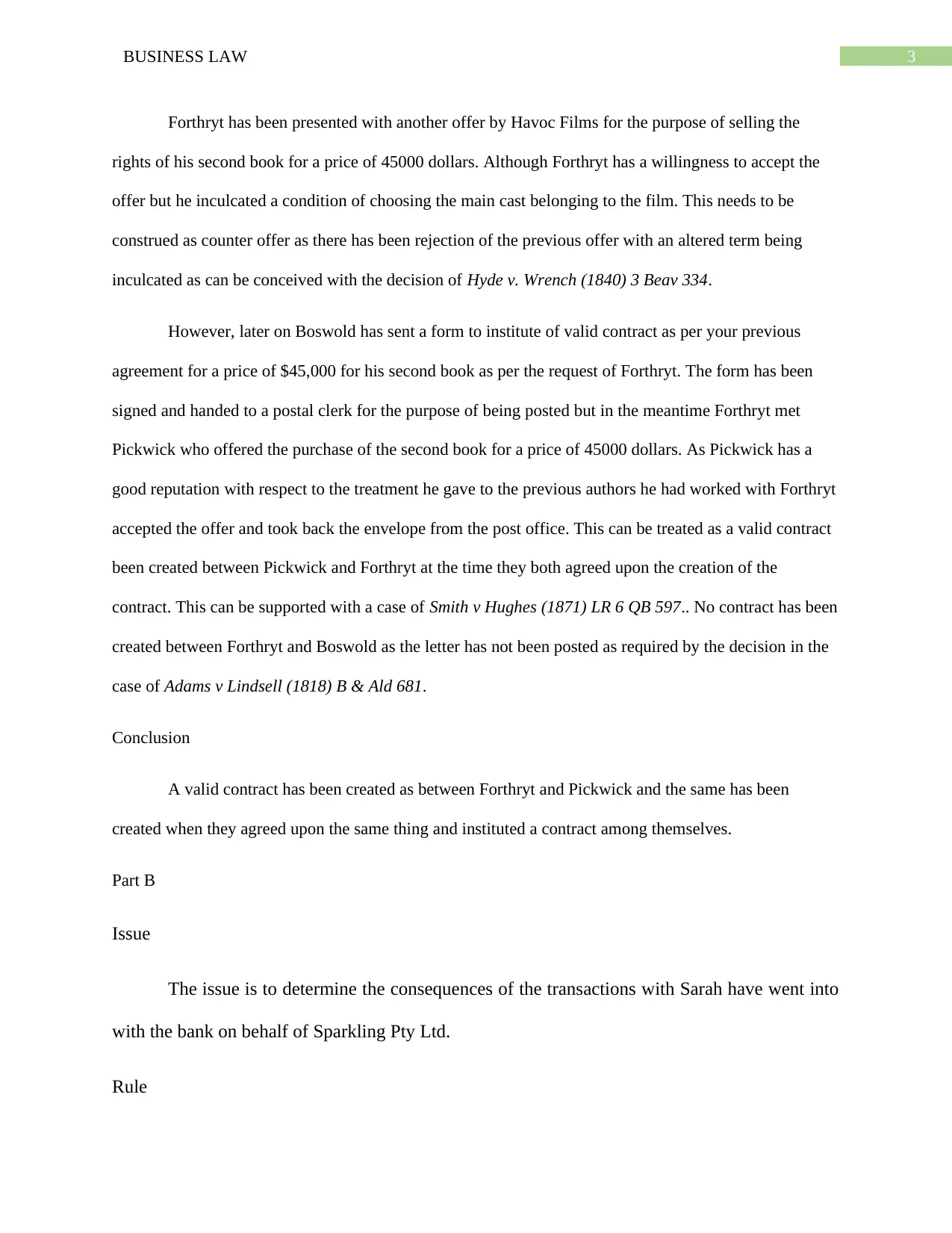
3BUSINESS LAW
Forthryt has been presented with another offer by Havoc Films for the purpose of selling the
rights of his second book for a price of 45000 dollars. Although Forthryt has a willingness to accept the
offer but he inculcated a condition of choosing the main cast belonging to the film. This needs to be
construed as counter offer as there has been rejection of the previous offer with an altered term being
inculcated as can be conceived with the decision of Hyde v. Wrench (1840) 3 Beav 334.
However, later on Boswold has sent a form to institute of valid contract as per your previous
agreement for a price of $45,000 for his second book as per the request of Forthryt. The form has been
signed and handed to a postal clerk for the purpose of being posted but in the meantime Forthryt met
Pickwick who offered the purchase of the second book for a price of 45000 dollars. As Pickwick has a
good reputation with respect to the treatment he gave to the previous authors he had worked with Forthryt
accepted the offer and took back the envelope from the post office. This can be treated as a valid contract
been created between Pickwick and Forthryt at the time they both agreed upon the creation of the
contract. This can be supported with a case of Smith v Hughes (1871) LR 6 QB 597.. No contract has been
created between Forthryt and Boswold as the letter has not been posted as required by the decision in the
case of Adams v Lindsell (1818) B & Ald 681.
Conclusion
A valid contract has been created as between Forthryt and Pickwick and the same has been
created when they agreed upon the same thing and instituted a contract among themselves.
Part B
Issue
The issue is to determine the consequences of the transactions with Sarah have went into
with the bank on behalf of Sparkling Pty Ltd.
Rule
Forthryt has been presented with another offer by Havoc Films for the purpose of selling the
rights of his second book for a price of 45000 dollars. Although Forthryt has a willingness to accept the
offer but he inculcated a condition of choosing the main cast belonging to the film. This needs to be
construed as counter offer as there has been rejection of the previous offer with an altered term being
inculcated as can be conceived with the decision of Hyde v. Wrench (1840) 3 Beav 334.
However, later on Boswold has sent a form to institute of valid contract as per your previous
agreement for a price of $45,000 for his second book as per the request of Forthryt. The form has been
signed and handed to a postal clerk for the purpose of being posted but in the meantime Forthryt met
Pickwick who offered the purchase of the second book for a price of 45000 dollars. As Pickwick has a
good reputation with respect to the treatment he gave to the previous authors he had worked with Forthryt
accepted the offer and took back the envelope from the post office. This can be treated as a valid contract
been created between Pickwick and Forthryt at the time they both agreed upon the creation of the
contract. This can be supported with a case of Smith v Hughes (1871) LR 6 QB 597.. No contract has been
created between Forthryt and Boswold as the letter has not been posted as required by the decision in the
case of Adams v Lindsell (1818) B & Ald 681.
Conclusion
A valid contract has been created as between Forthryt and Pickwick and the same has been
created when they agreed upon the same thing and instituted a contract among themselves.
Part B
Issue
The issue is to determine the consequences of the transactions with Sarah have went into
with the bank on behalf of Sparkling Pty Ltd.
Rule
Paraphrase This Document
Need a fresh take? Get an instant paraphrase of this document with our AI Paraphraser
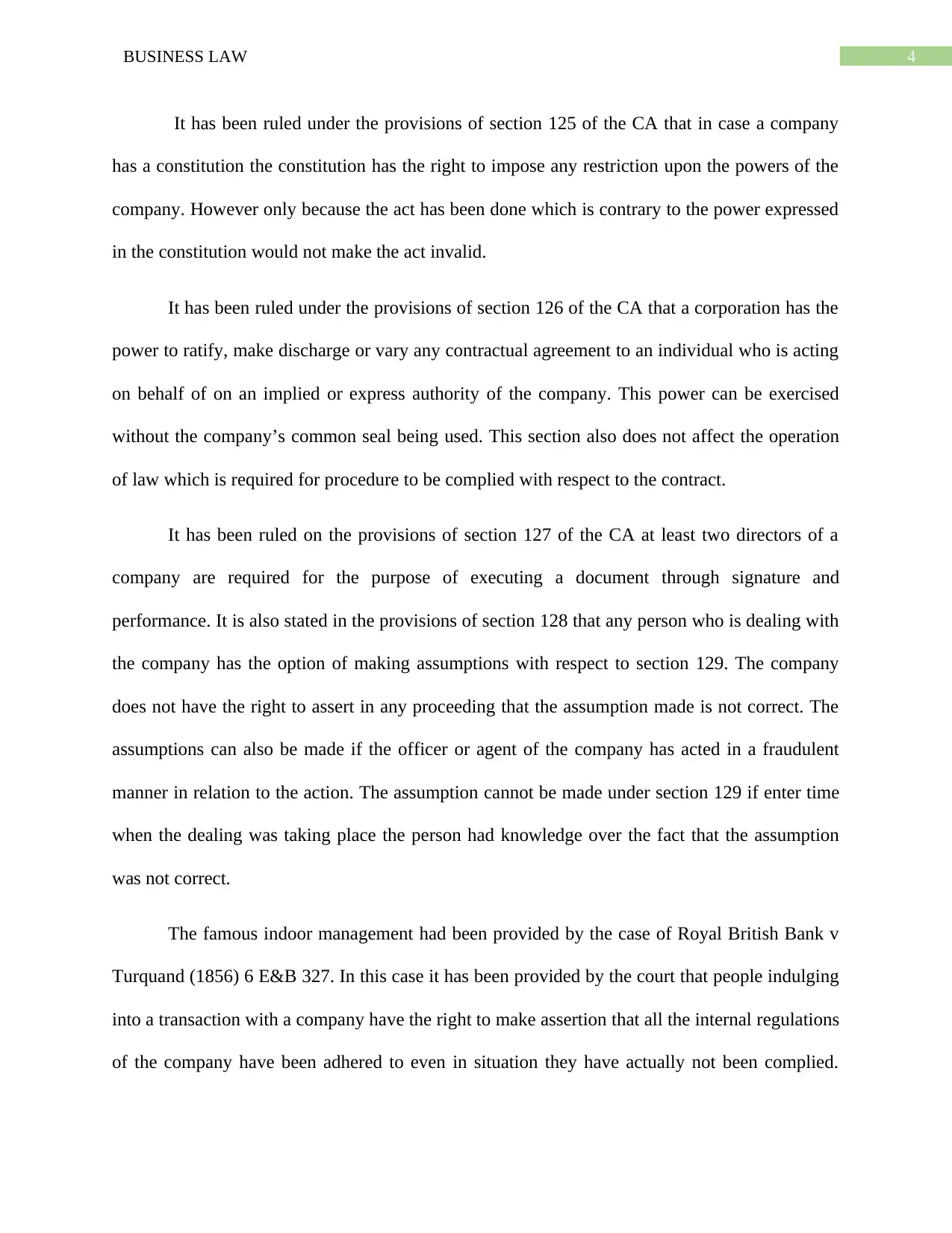
4BUSINESS LAW
It has been ruled under the provisions of section 125 of the CA that in case a company
has a constitution the constitution has the right to impose any restriction upon the powers of the
company. However only because the act has been done which is contrary to the power expressed
in the constitution would not make the act invalid.
It has been ruled under the provisions of section 126 of the CA that a corporation has the
power to ratify, make discharge or vary any contractual agreement to an individual who is acting
on behalf of on an implied or express authority of the company. This power can be exercised
without the company’s common seal being used. This section also does not affect the operation
of law which is required for procedure to be complied with respect to the contract.
It has been ruled on the provisions of section 127 of the CA at least two directors of a
company are required for the purpose of executing a document through signature and
performance. It is also stated in the provisions of section 128 that any person who is dealing with
the company has the option of making assumptions with respect to section 129. The company
does not have the right to assert in any proceeding that the assumption made is not correct. The
assumptions can also be made if the officer or agent of the company has acted in a fraudulent
manner in relation to the action. The assumption cannot be made under section 129 if enter time
when the dealing was taking place the person had knowledge over the fact that the assumption
was not correct.
The famous indoor management had been provided by the case of Royal British Bank v
Turquand (1856) 6 E&B 327. In this case it has been provided by the court that people indulging
into a transaction with a company have the right to make assertion that all the internal regulations
of the company have been adhered to even in situation they have actually not been complied.
It has been ruled under the provisions of section 125 of the CA that in case a company
has a constitution the constitution has the right to impose any restriction upon the powers of the
company. However only because the act has been done which is contrary to the power expressed
in the constitution would not make the act invalid.
It has been ruled under the provisions of section 126 of the CA that a corporation has the
power to ratify, make discharge or vary any contractual agreement to an individual who is acting
on behalf of on an implied or express authority of the company. This power can be exercised
without the company’s common seal being used. This section also does not affect the operation
of law which is required for procedure to be complied with respect to the contract.
It has been ruled on the provisions of section 127 of the CA at least two directors of a
company are required for the purpose of executing a document through signature and
performance. It is also stated in the provisions of section 128 that any person who is dealing with
the company has the option of making assumptions with respect to section 129. The company
does not have the right to assert in any proceeding that the assumption made is not correct. The
assumptions can also be made if the officer or agent of the company has acted in a fraudulent
manner in relation to the action. The assumption cannot be made under section 129 if enter time
when the dealing was taking place the person had knowledge over the fact that the assumption
was not correct.
The famous indoor management had been provided by the case of Royal British Bank v
Turquand (1856) 6 E&B 327. In this case it has been provided by the court that people indulging
into a transaction with a company have the right to make assertion that all the internal regulations
of the company have been adhered to even in situation they have actually not been complied.
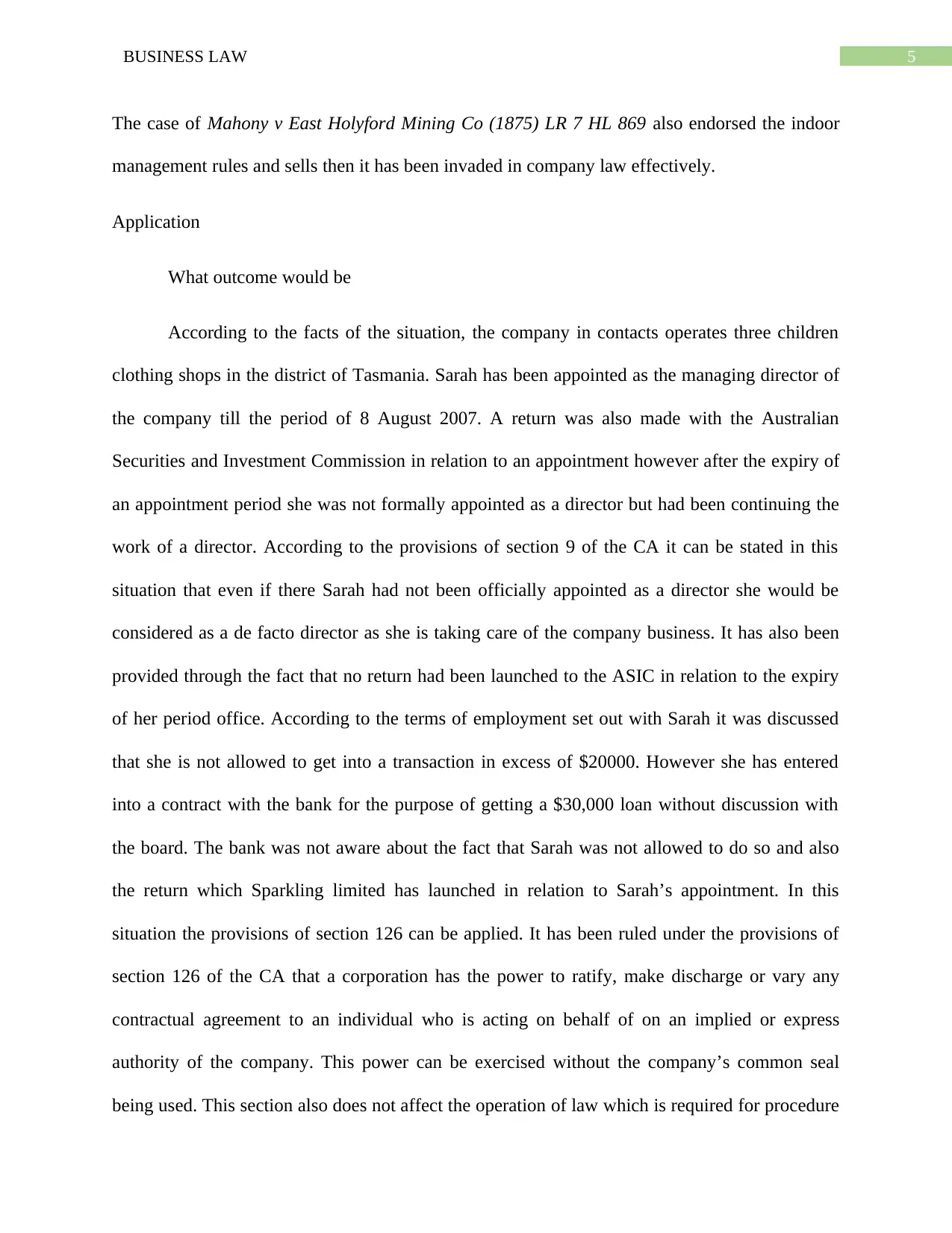
5BUSINESS LAW
The case of Mahony v East Holyford Mining Co (1875) LR 7 HL 869 also endorsed the indoor
management rules and sells then it has been invaded in company law effectively.
Application
What outcome would be
According to the facts of the situation, the company in contacts operates three children
clothing shops in the district of Tasmania. Sarah has been appointed as the managing director of
the company till the period of 8 August 2007. A return was also made with the Australian
Securities and Investment Commission in relation to an appointment however after the expiry of
an appointment period she was not formally appointed as a director but had been continuing the
work of a director. According to the provisions of section 9 of the CA it can be stated in this
situation that even if there Sarah had not been officially appointed as a director she would be
considered as a de facto director as she is taking care of the company business. It has also been
provided through the fact that no return had been launched to the ASIC in relation to the expiry
of her period office. According to the terms of employment set out with Sarah it was discussed
that she is not allowed to get into a transaction in excess of $20000. However she has entered
into a contract with the bank for the purpose of getting a $30,000 loan without discussion with
the board. The bank was not aware about the fact that Sarah was not allowed to do so and also
the return which Sparkling limited has launched in relation to Sarah’s appointment. In this
situation the provisions of section 126 can be applied. It has been ruled under the provisions of
section 126 of the CA that a corporation has the power to ratify, make discharge or vary any
contractual agreement to an individual who is acting on behalf of on an implied or express
authority of the company. This power can be exercised without the company’s common seal
being used. This section also does not affect the operation of law which is required for procedure
The case of Mahony v East Holyford Mining Co (1875) LR 7 HL 869 also endorsed the indoor
management rules and sells then it has been invaded in company law effectively.
Application
What outcome would be
According to the facts of the situation, the company in contacts operates three children
clothing shops in the district of Tasmania. Sarah has been appointed as the managing director of
the company till the period of 8 August 2007. A return was also made with the Australian
Securities and Investment Commission in relation to an appointment however after the expiry of
an appointment period she was not formally appointed as a director but had been continuing the
work of a director. According to the provisions of section 9 of the CA it can be stated in this
situation that even if there Sarah had not been officially appointed as a director she would be
considered as a de facto director as she is taking care of the company business. It has also been
provided through the fact that no return had been launched to the ASIC in relation to the expiry
of her period office. According to the terms of employment set out with Sarah it was discussed
that she is not allowed to get into a transaction in excess of $20000. However she has entered
into a contract with the bank for the purpose of getting a $30,000 loan without discussion with
the board. The bank was not aware about the fact that Sarah was not allowed to do so and also
the return which Sparkling limited has launched in relation to Sarah’s appointment. In this
situation the provisions of section 126 can be applied. It has been ruled under the provisions of
section 126 of the CA that a corporation has the power to ratify, make discharge or vary any
contractual agreement to an individual who is acting on behalf of on an implied or express
authority of the company. This power can be exercised without the company’s common seal
being used. This section also does not affect the operation of law which is required for procedure
⊘ This is a preview!⊘
Do you want full access?
Subscribe today to unlock all pages.

Trusted by 1+ million students worldwide
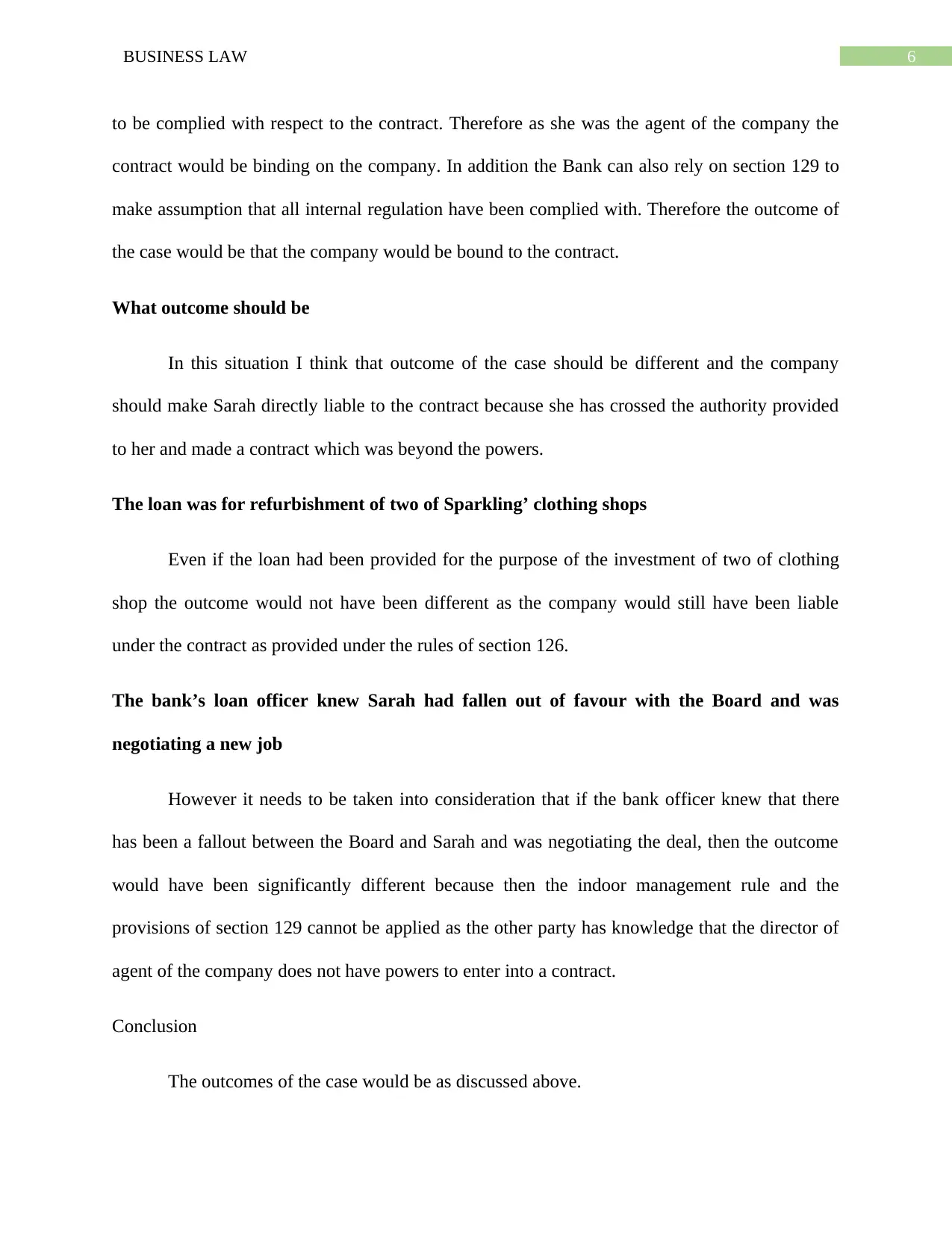
6BUSINESS LAW
to be complied with respect to the contract. Therefore as she was the agent of the company the
contract would be binding on the company. In addition the Bank can also rely on section 129 to
make assumption that all internal regulation have been complied with. Therefore the outcome of
the case would be that the company would be bound to the contract.
What outcome should be
In this situation I think that outcome of the case should be different and the company
should make Sarah directly liable to the contract because she has crossed the authority provided
to her and made a contract which was beyond the powers.
The loan was for refurbishment of two of Sparkling’ clothing shops
Even if the loan had been provided for the purpose of the investment of two of clothing
shop the outcome would not have been different as the company would still have been liable
under the contract as provided under the rules of section 126.
The bank’s loan officer knew Sarah had fallen out of favour with the Board and was
negotiating a new job
However it needs to be taken into consideration that if the bank officer knew that there
has been a fallout between the Board and Sarah and was negotiating the deal, then the outcome
would have been significantly different because then the indoor management rule and the
provisions of section 129 cannot be applied as the other party has knowledge that the director of
agent of the company does not have powers to enter into a contract.
Conclusion
The outcomes of the case would be as discussed above.
to be complied with respect to the contract. Therefore as she was the agent of the company the
contract would be binding on the company. In addition the Bank can also rely on section 129 to
make assumption that all internal regulation have been complied with. Therefore the outcome of
the case would be that the company would be bound to the contract.
What outcome should be
In this situation I think that outcome of the case should be different and the company
should make Sarah directly liable to the contract because she has crossed the authority provided
to her and made a contract which was beyond the powers.
The loan was for refurbishment of two of Sparkling’ clothing shops
Even if the loan had been provided for the purpose of the investment of two of clothing
shop the outcome would not have been different as the company would still have been liable
under the contract as provided under the rules of section 126.
The bank’s loan officer knew Sarah had fallen out of favour with the Board and was
negotiating a new job
However it needs to be taken into consideration that if the bank officer knew that there
has been a fallout between the Board and Sarah and was negotiating the deal, then the outcome
would have been significantly different because then the indoor management rule and the
provisions of section 129 cannot be applied as the other party has knowledge that the director of
agent of the company does not have powers to enter into a contract.
Conclusion
The outcomes of the case would be as discussed above.
Paraphrase This Document
Need a fresh take? Get an instant paraphrase of this document with our AI Paraphraser

7BUSINESS LAW
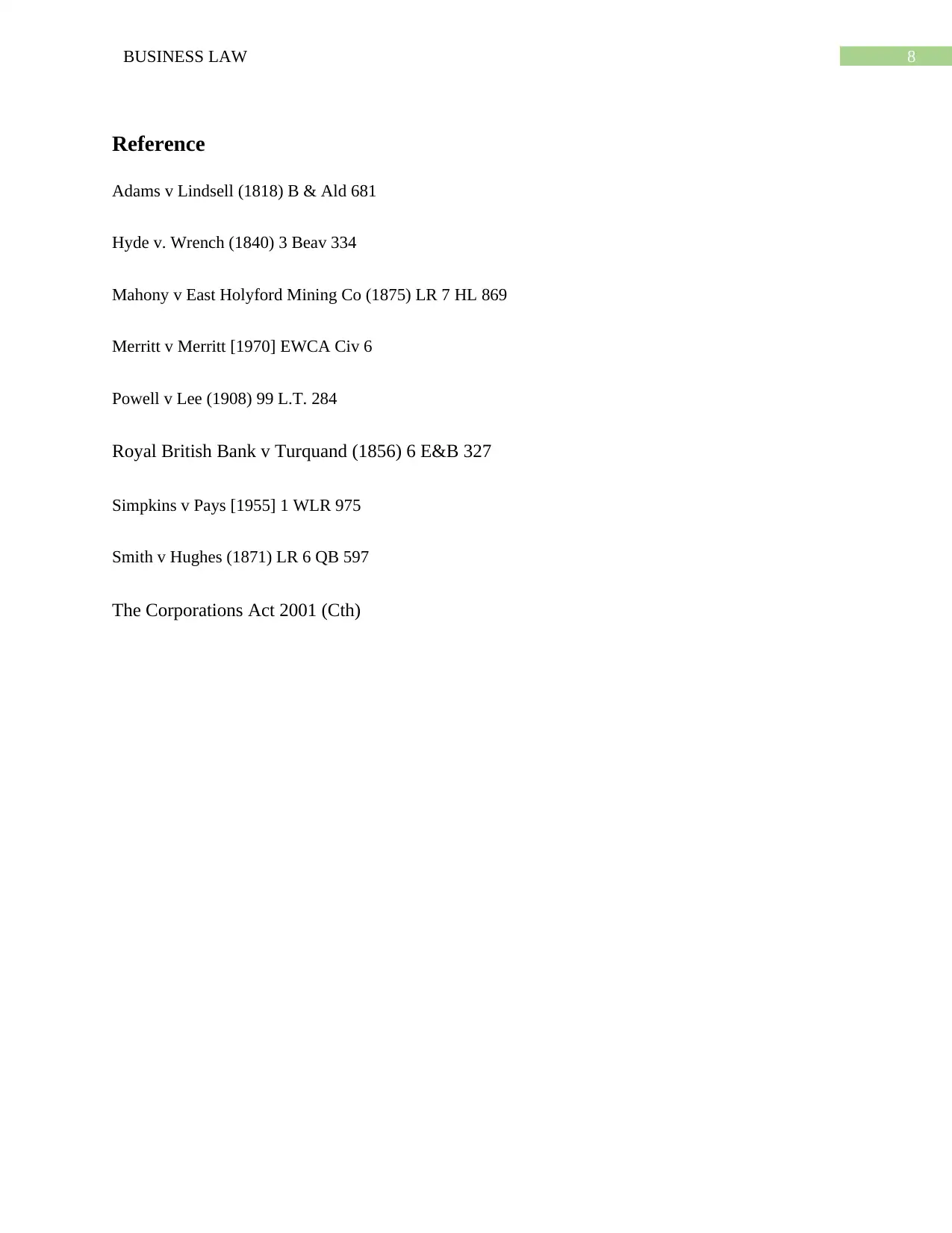
8BUSINESS LAW
Reference
Adams v Lindsell (1818) B & Ald 681
Hyde v. Wrench (1840) 3 Beav 334
Mahony v East Holyford Mining Co (1875) LR 7 HL 869
Merritt v Merritt [1970] EWCA Civ 6
Powell v Lee (1908) 99 L.T. 284
Royal British Bank v Turquand (1856) 6 E&B 327
Simpkins v Pays [1955] 1 WLR 975
Smith v Hughes (1871) LR 6 QB 597
The Corporations Act 2001 (Cth)
Reference
Adams v Lindsell (1818) B & Ald 681
Hyde v. Wrench (1840) 3 Beav 334
Mahony v East Holyford Mining Co (1875) LR 7 HL 869
Merritt v Merritt [1970] EWCA Civ 6
Powell v Lee (1908) 99 L.T. 284
Royal British Bank v Turquand (1856) 6 E&B 327
Simpkins v Pays [1955] 1 WLR 975
Smith v Hughes (1871) LR 6 QB 597
The Corporations Act 2001 (Cth)
⊘ This is a preview!⊘
Do you want full access?
Subscribe today to unlock all pages.

Trusted by 1+ million students worldwide
1 out of 9
Related Documents
Your All-in-One AI-Powered Toolkit for Academic Success.
+13062052269
info@desklib.com
Available 24*7 on WhatsApp / Email
![[object Object]](/_next/static/media/star-bottom.7253800d.svg)
Unlock your academic potential
Copyright © 2020–2025 A2Z Services. All Rights Reserved. Developed and managed by ZUCOL.





